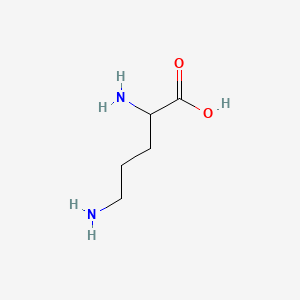2,5-diaminopentanoic acid
2,5-diaminopentanoic acid is a lipid of Fatty Acyls (FA) class. The involved functions are known as Vasodilation, Intestinal Absorption and Pinocytosis. 2,5-diaminopentanoic acid often locates in Mitochondria, Microfilaments, NADH dehydrogenase complex and respiratory chain complex III location sensu Eukarya. The associated genes with 2,5-diaminopentanoic acid are GAPDH gene and iberiotoxin.
Cross Reference
Introduction
To understand associated biological information of 2,5-diaminopentanoic acid, we collected biological information of abnormalities, associated pathways, cellular/molecular locations, biological functions, related genes/proteins, lipids and common seen animal/experimental models with organized paragraphs from literatures.
What diseases are associated with 2,5-diaminopentanoic acid?
There are no associated biomedical information in the current reference collection.
Possible diseases from mapped MeSH terms on references
We collected disease MeSH terms mapped to the references associated with 2,5-diaminopentanoic acid
PubChem Associated disorders and diseases
What pathways are associated with 2,5-diaminopentanoic acid
There are no associated biomedical information in the current reference collection.
PubChem Biomolecular Interactions and Pathways
Link to PubChem Biomolecular Interactions and PathwaysWhat cellular locations are associated with 2,5-diaminopentanoic acid?
Visualization in cellular structure
Associated locations are in red color. Not associated locations are in black.
Related references are published most in these journals:
| Location | Cross reference | Weighted score | Related literatures |
|---|
What functions are associated with 2,5-diaminopentanoic acid?
Related references are published most in these journals:
| Function | Cross reference | Weighted score | Related literatures |
|---|
What lipids are associated with 2,5-diaminopentanoic acid?
There are no associated biomedical information in the current reference collection.
What genes are associated with 2,5-diaminopentanoic acid?
Related references are published most in these journals:
| Gene | Cross reference | Weighted score | Related literatures |
|---|
What common seen animal models are associated with 2,5-diaminopentanoic acid?
There are no associated biomedical information in the current reference collection.
NCBI Entrez Crosslinks
All references with 2,5-diaminopentanoic acid
Download all related citations| Authors | Title | Published | Journal | PubMed Link |
|---|---|---|---|---|
| Macedo JP et al. | Ornithine uptake and the modulation of drug sensitivity in Trypanosoma brucei. | 2017 | FASEB J. | pmid:28679527 |
| Aguilera S et al. | Temperature-mediated biosynthesis of the phytotoxin phaseolotoxin by Pseudomonas syringae pv. phaseolicola depends on the autoregulated expression of the phtABC genes. | 2017 | PLoS ONE | pmid:28570637 |
| Ye Q et al. | The value of grip test, lysophosphatidlycholines, glycerophosphocholine, ornithine, glucuronic acid decrement in assessment of nutritional and metabolic characteristics in hepatitis B cirrhosis. | 2017 | PLoS ONE | pmid:28384211 |
| Noens EE and Lolkema JS | Convergent evolution of the arginine deiminase pathway: the ArcD and ArcE arginine/ornithine exchangers. | 2017 | Microbiologyopen | pmid:27804281 |
| Biron BM et al. | Cl-Amidine Prevents Histone 3 Citrullination and Neutrophil Extracellular Trap Formation, and Improves Survival in a Murine Sepsis Model. | 2017 | J Innate Immun | pmid:27622642 |
| Falone S et al. | Regular and Moderate Exercise Counteracts the Decline of Antioxidant Protection but Not Methylglyoxal-Dependent Glycative Burden in the Ovary of Reproductively Aging Mice. | 2016 | Oxid Med Cell Longev | pmid:28116035 |
| Qadri SK et al. | Milder Form of Urea Cycle Defect Revisited: Report and Review of Hyperornithinaemia-Hyperammonaemia-Homocitrullinuria (HHH) Syndrome Diagnosed in a Teenage Girl Presenting with Recurrent Encephalopathy. | 2016 | Ann. Acad. Med. Singap. | pmid:28062886 |
| Papadaki G et al. | Neutrophil extracellular traps exacerbate Th1-mediated autoimmune responses in rheumatoid arthritis by promoting DC maturation. | 2016 | Eur. J. Immunol. | pmid:27585946 |
| Keogh D et al. | Enterococcal Metabolite Cues Facilitate Interspecies Niche Modulation and Polymicrobial Infection. | 2016 | Cell Host Microbe | pmid:27736645 |
| Braster Q et al. | Inhibition of NET Release Fails to Reduce Adipose Tissue Inflammation in Mice. | 2016 | PLoS ONE | pmid:27701440 |
| Rotroff DM et al. | Metabolomic signatures of drug response phenotypes for ketamine and esketamine in subjects with refractory major depressive disorder: new mechanistic insights for rapid acting antidepressants. | 2016 | Transl Psychiatry | pmid:27648916 |
| Hu L et al. | Identification of arginine and its "Downstream" molecules as potential markers of breast cancer. | 2016 | IUBMB Life | pmid:27641058 |
| Yoshida A et al. | Lysine Biosynthesis of Thermococcus kodakarensis with the Capacity to Function as an Ornithine Biosynthetic System. | 2016 | J. Biol. Chem. | pmid:27566549 |
| Katoch M et al. | Heterologous Production of Cyanobacterial Mycosporine-Like Amino Acids Mycosporine-Ornithine and Mycosporine-Lysine in Escherichia coli. | 2016 | Appl. Environ. Microbiol. | pmid:27520810 |
| Watson CP et al. | The transporter and permeability interactions of asymmetric dimethylarginine (ADMA) and L-arginine with the human blood-brain barrier in vitro. | 2016 | Brain Res. | pmid:27431938 |
| Sayqal A et al. | Metabolomics Analysis Reveals the Participation of Efflux Pumps and Ornithine in the Response of Pseudomonas putida DOT-T1E Cells to Challenge with Propranolol. | 2016 | PLoS ONE | pmid:27331395 |
| Aziz MA et al. | Discovery of Potent VEGFR-2 Inhibitors based on Furopyrimidine and Thienopyrimidne Scaffolds as Cancer Targeting Agents. | 2016 | Sci Rep | pmid:27080011 |
| Nunez S et al. | A Versatile Murine Model of Subcortical White Matter Stroke for the Study of Axonal Degeneration and White Matter Neurobiology. | 2016 | J Vis Exp | pmid:27023377 |
| Koseki J et al. | A Trans-omics Mathematical Analysis Reveals Novel Functions of the Ornithine Metabolic Pathway in Cancer Stem Cells. | 2016 | Sci Rep | pmid:26864636 |
| Kobylarz MJ et al. | Deciphering the Substrate Specificity of SbnA, the Enzyme Catalyzing the First Step in Staphyloferrin B Biosynthesis. | 2016 | Biochemistry | pmid:26794841 |
